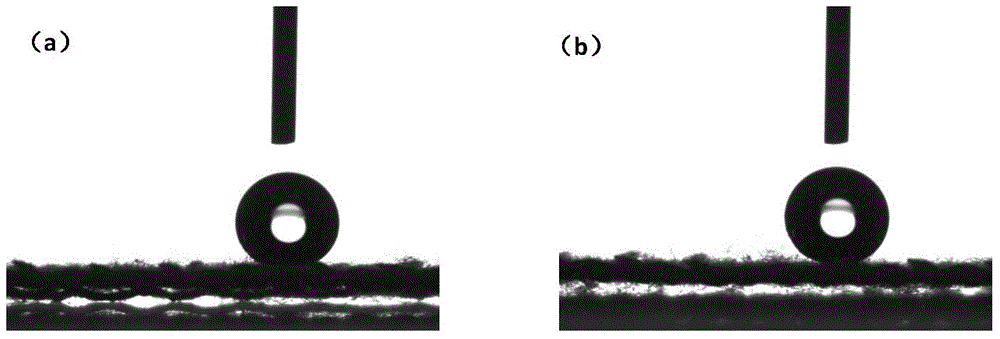Method for preparing super-hydrophobic textiles through fiber surface polymerization modification
A fiber surface, super-hydrophobic technology, applied in the field of preparation of functional textiles, can solve the problems of high hazards for operators, weak force, and harsh equipment requirements
- Summary
- Abstract
- Description
- Claims
- Application Information
AI Technical Summary
Problems solved by technology
Method used
Image
Examples
Embodiment 1
[0032] Step 1: Activate the surface of the fiber: place the polyester fabric (15cm x 25cm) in deionized water and 25g / L NaOH solution successively, wash at 80°C for 30min, then wash with dilute hydrochloric acid, deionized water and acetone for several times Once, dry at 80°C.
[0033] Step 2: Fix the initiator: Put the activated polyester fabric into a dyeing cup containing only 0.01mL 2-bromoisobutyryl bromide, heat it at 70°C for 90min, then take it out, and wash it with absolute ethanol and deionized water successively Wash several times and dry at 80°C.
[0034]Step 3: Hydrophobic modification of the fiber surface by in-situ polymerization: put the polyester immobilized with the initiator into 0.005g of CuBr, 0.005g of bipyridine, 0.04g of glucose, 60mL of tetrahydrofuran, and 0.01mL of ethyl 2-bromoisobutyrate , 8mL of a mixture of 2,2,2-trifluoroethyl methacrylate monomers, sealed, and reacted at 60°C for 8 hours. After taking it out, wash it successively with tetrahyd...
Embodiment 2
[0037] Step 1: Activate the surface of the fiber: place the polyester fabric (15cm x 25cm) in deionized water and 25g / L NaOH solution successively, wash at 80°C for 30min, then wash with dilute hydrochloric acid, deionized water and acetone for several times Once, dry at 80°C.
[0038] Step 2: Fix the initiator: Put the activated polyester fabric into a dyeing cup containing only 0.01mL 2-bromoisobutyryl bromide, heat it at 70°C for 90min, then take it out, and wash it with absolute ethanol and deionized water successively Wash several times and dry at 80°C.
[0039] Step 3: Hydrophobic modification of the fiber surface by in-situ polymerization: put the polyester with the initiator fixed in 0.005g of CuBr, 0.025g of bipyridine, 0.01g of glucose, 60mL of tetrahydrofuran, and 0.01mL of ethyl 2-bromoisobutyrate , 8mL 2,2,2-Trifluoroethyl methacrylate monomer mixture, sealed, and reacted at 60°C for 5h, after taking it out, wash it successively with tetrahydrofuran, absolute eth...
Embodiment 3
[0042] Step 1: Activate the surface of the fiber: place the polyester fabric (15cm x 25cm) in deionized water and 25g / L NaOH solution successively, wash at 80°C for 30min, then wash with dilute hydrochloric acid, deionized water and acetone for several times Once, dry at 80°C.
[0043] Step 2: Fix the initiator: Put the activated polyester fabric into a dyeing cup containing only 0.01mL 2-bromoisobutyryl bromide, heat it at 90°C for 90min, then take it out, and wash it with absolute ethanol and deionized water successively Wash several times and dry at 80°C.
[0044] Step 3: Hydrophobic modification of the fiber surface by in-situ polymerization: put the polyester immobilized with the initiator into a solution containing 0.003g of CuBr, 0.009g of bipyridine, 0.06g of glucose, 60mL of tetrahydrofuran, and 0.01mL of ethyl 2-bromoisobutyrate , 8mL of a mixture of 2,2,2-trifluoroethyl methacrylate monomers, sealed, and reacted at 50°C for 8 hours. After taking it out, wash it suc...
PUM
 Login to View More
Login to View More Abstract
Description
Claims
Application Information
 Login to View More
Login to View More - R&D
- Intellectual Property
- Life Sciences
- Materials
- Tech Scout
- Unparalleled Data Quality
- Higher Quality Content
- 60% Fewer Hallucinations
Browse by: Latest US Patents, China's latest patents, Technical Efficacy Thesaurus, Application Domain, Technology Topic, Popular Technical Reports.
© 2025 PatSnap. All rights reserved.Legal|Privacy policy|Modern Slavery Act Transparency Statement|Sitemap|About US| Contact US: help@patsnap.com

